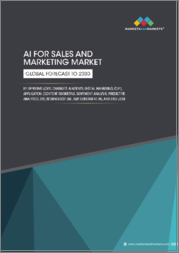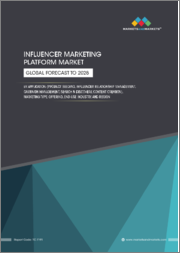
|
시장보고서
상품코드
1734420
세계의 컨텐츠 마케팅 시장 규모, 점유율, 성장 분석, 컨텐츠 유형별, 포맷별, 기술 통합별, 유통 채널별, 산업 분야별, 지역별 - 산업 예측(2025-2032년)Content Marketing Market Size, Share, and Growth Analysis, By Content Type (Blog Posts, Social Media Posts), By Format (Text, Visual), By Technology Integration, By Distribution Channel, By Industry Vertical, By Region - Industry Forecast 2025-2032 |
||||||
컨텐츠 마케팅 마케팅 세계 시장 규모는 2023년 720억 달러, 2024년 824억 4,000만 달러에서 2032년에는 2,435억 5,000만 달러로 성장하고, 예측 기간중(2025년-2032년) CAGR은 14.5%를 나타낼 전망입니다.
디지털 미디어 소비 트렌드는 유기적 트래픽의 중요한 역할과 함께 컨텐츠 마케팅 마케팅에 대한 수요를 촉진하고 있습니다. 스마트폰과 인터넷 연결의 보급으로 소비자의 디지털 컨텐츠 마케팅에 대한 관심이 높아짐에 따라 기업들은 전통적인 마케팅에서 디지털 플랫폼으로 전환하고 있으며, 이는 이 분야의 성장에 박차를 가하고 있습니다. 검색엔진 최적화를 중시하고 인지도를 높이는 것이 필수적입니다. 개인화 마케팅과 동영상 컨텐츠 마케팅 소비 증가는 이러한 수요에 더욱 영향을 미치고 있으며, 인플루언서 마케팅과 제휴 마케팅은 효과적인 컨텐츠 마케팅 전략의 핵심 요소로 자리 잡았습니다. 그러나 컨텐츠 마케팅의 포화, ROI 측정, 규제적 장애물 등의 문제가 시장 확대를 저해할 수 있습니다. 컨텐츠 마케팅이 지속적으로 성장하기 위해서는 혁신과 이러한 과제에 대한 대응의 균형을 유지하는 것이 필수적입니다.
목차
서론
- 조사 목적
- 조사 범위
- 정의
조사 방법
- 정보 조달
- 2차와 1차 데이터 방법
- 시장 규모 예측
- 시장 전제조건과 제한
주요 요약
- 세계 시장 전망
- 공급과 수요 동향 분석
- 부문별 기회 분석
시장 역학과 전망
- 시장 개요
- 시장 규모
- 시장 역학
- 성장 촉진요인과 기회
- 성장 억제요인과 과제
- Porter의 Five Forces 분석
주요 시장 인사이트
- 중요 성공 요인
- 경쟁 정도
- 주요 투자 기회
- 시장 생태계
- 시장의 매력 지수(2024년)
- PESTEL 분석
- 거시경제 지표
- 밸류체인 분석
- 가격 분석
- 기술 분석
- 사례 연구
컨텐츠 마케팅 시장 규모 : 컨텐츠 유형별&CAGR(2025-2032)
- 시장 개요
- 블로그 투고
- 소셜미디어 투고
- 비디오
- 인포메이션 그래픽
- 팟캐스트
컨텐츠 마케팅 시장 규모 : 포맷별&CAGR(2025-2032)
- 시장 개요
- 텍스트
- 비주얼
- 오디오
- 상호 작용
컨텐츠 마케팅 시장 규모 : 기술 통합별&CAGR(2025-2032)
- 시장 개요
- AI 기반
- 비AI 기반
컨텐츠 마케팅 시장 규모 : 유통 채널별&CAGR(2025-2032)
- 시장 개요
- Owned Media
- Paid Media
- Earned Media
컨텐츠 마케팅 시장 규모 : 산업 분야별&CAGR(2025-2032)
- 시장 개요
- B2B
- B2C
- E-Commerce
- 교육
- 헬스케어
컨텐츠 마케팅 시장 규모 : 지역별&CAGR(2025-2032)
- 북미
- 미국
- 캐나다
- 유럽
- 독일
- 스페인
- 프랑스
- 영국
- 이탈리아
- 기타 유럽
- 아시아태평양
- 중국
- 인도
- 일본
- 한국
- 기타 아시아태평양
- 라틴아메리카
- 브라질
- 기타 라틴아메리카
- 중동 및 아프리카
- GCC 국가
- 남아프리카공화국
- 기타 중동 및 아프리카
경쟁 정보
- 주요 5개사 비교
- 주요 기업의 시장 포지셔닝(2024년)
- 주요 시장 기업이 채택한 전략
- 최근 시장 동향
- 기업의 시장 점유율 분석(2024년)
- 주요 기업 개요
- 기업 상세
- 제품 포트폴리오 분석
- 기업 부문별 점유율 분석
- 매출 전년대비 비교(2022-2024년)
주요 기업 개요
- Adobe Inc.(USA)
- Aghreni Technologies Pvt. Ltd.(India)
- Alma Media Corp.(Finland)
- Brafton Inc.(USA)
- Contentoo B.V.(Netherlands)
- CoSchedule LLC(USA)
- Curata Inc.(USA)
- Hootsuite Inc.(Canada)
- HubSpot Inc.(USA)
- Influence and Co.(USA)
- InterAct Marketing(USA)
- IZEA Worldwide Inc.(USA)
- NewsCred(USA)
- Rock Content(Brazil)
- Seismic Software Inc.(USA)
- Skyword Inc.(USA)
- Sprinklr Inc.(USA)
- Upland Software Inc.(USA)
결론과 제안
LSH 25.06.11Global Content Marketing Market size was valued at USD 72.0 billion in 2023 and is poised to grow from USD 82.44 billion in 2024 to USD 243.55 billion by 2032, growing at a CAGR of 14.5% during the forecast period (2025-2032).
The growing trend of digital media consumption, alongside the crucial role of organic traffic, is driving demand for content marketing. As consumers increasingly engage with digital content due to the widespread use of smartphones and internet connectivity, businesses are shifting from traditional marketing to digital platforms, fueling growth in this sector. Emphasizing search engine optimization to enhance visibility is essential. The rise of personalized marketing and video content consumption further influences this demand, with influencer and affiliate marketing becoming key components of effective content strategies. However, challenges such as content saturation, measuring ROI, and regulatory hurdles may impede the market's expansion. Maintaining a balance between innovation and addressing these challenges will be vital for sustained growth in content marketing.
Top-down and bottom-up approaches were used to estimate and validate the size of the Global Content market and to estimate the size of various other dependent submarkets. The research methodology used to estimate the market size includes the following details: The key players in the market were identified through secondary research, and their market shares in the respective regions were determined through primary and secondary research. This entire procedure includes the study of the annual and financial reports of the top market players and extensive interviews for key insights from industry leaders such as CEOs, VPs, directors, and marketing executives. All percentage shares split, and breakdowns were determined using secondary sources and verified through Primary sources. All possible parameters that affect the markets covered in this research study have been accounted for, viewed in extensive detail, verified through primary research, and analyzed to get the final quantitative and qualitative data.
Global Content Market Segments Analysis
Global Content Marketing Market is segmented by Content Type, Format, Technology Integration, Distribution Channel, Industry Vertical and region. Based on Content Type, the market is segmented into Blog Posts, Social Media Posts, Videos, Infographics and Podcasts. Based on Format, the market is segmented into Text, Visual, Audio and Interactive. Based on Technology Integration, the market is segmented into AI-driven and Non-AI-driven. Based on Distribution Channel, the market is segmented into Owned Media, Paid Media and Earned Media. Based on Industry Vertical, the market is segmented into B2B, B2C, E-commerce, Education and Healthcare. Based on region, the market is segmented into North America, Europe, Asia Pacific, Latin America and Middle East & Africa.
Driver of the Global Content Market
One of the key factors propelling the global content marketing market is the growing emphasis on personalization, which significantly elevates customer experiences and fosters engagement. Content marketing empowers businesses to craft personalized, value-oriented messages tailored to various audience segments throughout their purchasing journeys. Leveraging tools such as customer relationship management (CRM) systems and AI-driven analytics, companies can customize content based on individual behaviors, interests, and demographics. Strategies like personalized email campaigns, retargeting advertisements, and curated content strategies enhance conversion rates and customer loyalty. Consequently, the surge in personalized marketing initiatives is positively influencing the trajectory of the global content marketing market.
Restraints in the Global Content Market
The global content market faces significant challenges due to the overwhelming amount of content generated on a daily basis, resulting in intense competition for consumer attention. In such saturated markets, distinguishing one's content becomes increasingly difficult, leading to diminished effectiveness even for high-quality materials. To achieve visibility, businesses must allocate more resources towards research, creativity, and promotional efforts. Additionally, algorithms that prioritize established authoritative sources further complicate the landscape, making it arduous for newcomers to achieve organic traction through content marketing strategies alone. These factors collectively hinder the widespread adoption of effective content marketing practices.
Market Trends of the Global Content Market
The global content market is witnessing a significant shift towards interactive and immersive formats, signaling a transformative trend in content marketing. As brands strive to enhance audience engagement and retention, they are increasingly adopting innovative approaches such as quizzes, polls, augmented reality filters, 360° videos, shoppable content, and gamified storytelling. These dynamic formats not only cultivate real-time participant involvement but also facilitate the collection of behavioral data, enabling deeper personalization. By prioritizing interactive content, companies can considerably improve user experience, lead generation, and conversion rates, making it essential for brands to embrace this trend to remain competitive in the evolving digital landscape.
Table of Contents
Introduction
- Objectives of the Study
- Scope of the Report
- Definitions
Research Methodology
- Information Procurement
- Secondary & Primary Data Methods
- Market Size Estimation
- Market Assumptions & Limitations
Executive Summary
- Global Market Outlook
- Supply & Demand Trend Analysis
- Segmental Opportunity Analysis
Market Dynamics & Outlook
- Market Overview
- Market Size
- Market Dynamics
- Drivers & Opportunities
- Restraints & Challenges
- Porters Analysis
- Competitive rivalry
- Threat of substitute
- Bargaining power of buyers
- Threat of new entrants
- Bargaining power of suppliers
Key Market Insights
- Key Success Factors
- Degree of Competition
- Top Investment Pockets
- Market Ecosystem
- Market Attractiveness Index, 2024
- PESTEL Analysis
- Macro-Economic Indicators
- Value Chain Analysis
- Pricing Analysis
- Technology Analysis
- Case Studies
Global Content Marketing Market Size by Content Type & CAGR (2025-2032)
- Market Overview
- Blog Posts
- Social Media Posts
- Videos
- Infographics
- Podcasts
Global Content Marketing Market Size by Format & CAGR (2025-2032)
- Market Overview
- Text
- Visual
- Audio
- Interactive
Global Content Marketing Market Size by Technology Integration & CAGR (2025-2032)
- Market Overview
- AI-driven
- Non-AI-driven
Global Content Marketing Market Size by Distribution Channel & CAGR (2025-2032)
- Market Overview
- Owned Media
- Paid Media
- Earned Media
Global Content Marketing Market Size by Industry Vertical & CAGR (2025-2032)
- Market Overview
- B2B
- B2C
- E-commerce
- Education
- Healthcare
Global Content Marketing Market Size & CAGR (2025-2032)
- North America (Content Type, Format, Technology Integration, Distribution Channel, Industry Vertical)
- US
- Canada
- Europe (Content Type, Format, Technology Integration, Distribution Channel, Industry Vertical)
- Germany
- Spain
- France
- UK
- Italy
- Rest of Europe
- Asia Pacific (Content Type, Format, Technology Integration, Distribution Channel, Industry Vertical)
- China
- India
- Japan
- South Korea
- Rest of Asia-Pacific
- Latin America (Content Type, Format, Technology Integration, Distribution Channel, Industry Vertical)
- Brazil
- Rest of Latin America
- Middle East & Africa (Content Type, Format, Technology Integration, Distribution Channel, Industry Vertical)
- GCC Countries
- South Africa
- Rest of Middle East & Africa
Competitive Intelligence
- Top 5 Player Comparison
- Market Positioning of Key Players, 2024
- Strategies Adopted by Key Market Players
- Recent Developments in the Market
- Company Market Share Analysis, 2024
- Company Profiles of All Key Players
- Company Details
- Product Portfolio Analysis
- Company's Segmental Share Analysis
- Revenue Y-O-Y Comparison (2022-2024)
Key Company Profiles
- Adobe Inc. (USA)
- Company Overview
- Business Segment Overview
- Financial Updates
- Key Developments
- Aghreni Technologies Pvt. Ltd. (India)
- Company Overview
- Business Segment Overview
- Financial Updates
- Key Developments
- Alma Media Corp. (Finland)
- Company Overview
- Business Segment Overview
- Financial Updates
- Key Developments
- Brafton Inc. (USA)
- Company Overview
- Business Segment Overview
- Financial Updates
- Key Developments
- Contentoo B.V. (Netherlands)
- Company Overview
- Business Segment Overview
- Financial Updates
- Key Developments
- CoSchedule LLC (USA)
- Company Overview
- Business Segment Overview
- Financial Updates
- Key Developments
- Curata Inc. (USA)
- Company Overview
- Business Segment Overview
- Financial Updates
- Key Developments
- Hootsuite Inc. (Canada)
- Company Overview
- Business Segment Overview
- Financial Updates
- Key Developments
- HubSpot Inc. (USA)
- Company Overview
- Business Segment Overview
- Financial Updates
- Key Developments
- Influence and Co. (USA)
- Company Overview
- Business Segment Overview
- Financial Updates
- Key Developments
- InterAct Marketing (USA)
- Company Overview
- Business Segment Overview
- Financial Updates
- Key Developments
- IZEA Worldwide Inc. (USA)
- Company Overview
- Business Segment Overview
- Financial Updates
- Key Developments
- NewsCred (USA)
- Company Overview
- Business Segment Overview
- Financial Updates
- Key Developments
- Rock Content (Brazil)
- Company Overview
- Business Segment Overview
- Financial Updates
- Key Developments
- Seismic Software Inc. (USA)
- Company Overview
- Business Segment Overview
- Financial Updates
- Key Developments
- Skyword Inc. (USA)
- Company Overview
- Business Segment Overview
- Financial Updates
- Key Developments
- Sprinklr Inc. (USA)
- Company Overview
- Business Segment Overview
- Financial Updates
- Key Developments
- Upland Software Inc. (USA)
- Company Overview
- Business Segment Overview
- Financial Updates
- Key Developments



















